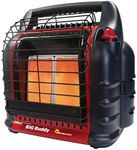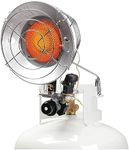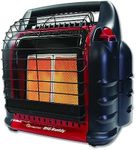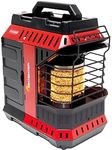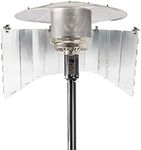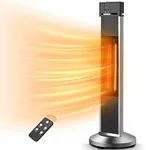Buying Guide for the Best Portable Propane Heaters
When choosing a portable propane heater, it's important to consider several key specifications to ensure you select the best model for your needs. Portable propane heaters are great for providing warmth in outdoor settings, garages, workshops, or even during emergencies. Understanding the key specs will help you make an informed decision and ensure you get a heater that is safe, efficient, and suitable for your intended use.BTU RatingBTU stands for British Thermal Unit and measures the amount of heat a heater can produce. This spec is important because it determines how much space the heater can effectively warm. Heaters with a lower BTU rating (around 3,000-5,000 BTUs) are suitable for small spaces or personal use, while those with a higher BTU rating (up to 30,000 BTUs or more) can heat larger areas. To pick the right one, consider the size of the area you need to heat and choose a heater with an appropriate BTU rating to ensure adequate warmth.
PortabilityPortability refers to how easy it is to move the heater from one location to another. This is important if you plan to use the heater in different places or need to store it when not in use. Look for features like a compact design, lightweight construction, and carrying handles. If you need to move the heater frequently, opt for a model that is easy to transport and set up.
Safety FeaturesSafety features are crucial for preventing accidents and ensuring safe operation. Common safety features include tip-over protection, which automatically shuts off the heater if it is knocked over, and an oxygen depletion sensor (ODS), which turns off the heater if oxygen levels drop too low. When choosing a heater, prioritize models with these safety features, especially if you plan to use the heater in enclosed or poorly ventilated spaces.
Fuel ConsumptionFuel consumption indicates how much propane the heater uses over a certain period. This is important for understanding how long the heater can run on a single propane tank. Heaters with lower fuel consumption are more efficient and can run longer on the same amount of fuel. To pick the right one, consider how often and for how long you plan to use the heater, and choose a model with a fuel consumption rate that matches your needs.
Ignition TypeIgnition type refers to how the heater is started. Common types include manual ignition, where you light the heater with a match or lighter, and electronic ignition, which uses a push-button or switch to start the heater. Electronic ignition is generally more convenient and safer, as it eliminates the need for an open flame. Choose the ignition type that best suits your preference for ease of use and safety.
Heat SettingsHeat settings allow you to adjust the output of the heater to control the temperature. This is important for maintaining comfort and conserving fuel. Some heaters have multiple heat settings, while others may have a single fixed output. If you need flexibility in temperature control, look for a model with adjustable heat settings. This will allow you to customize the heat output based on your needs and the conditions.
